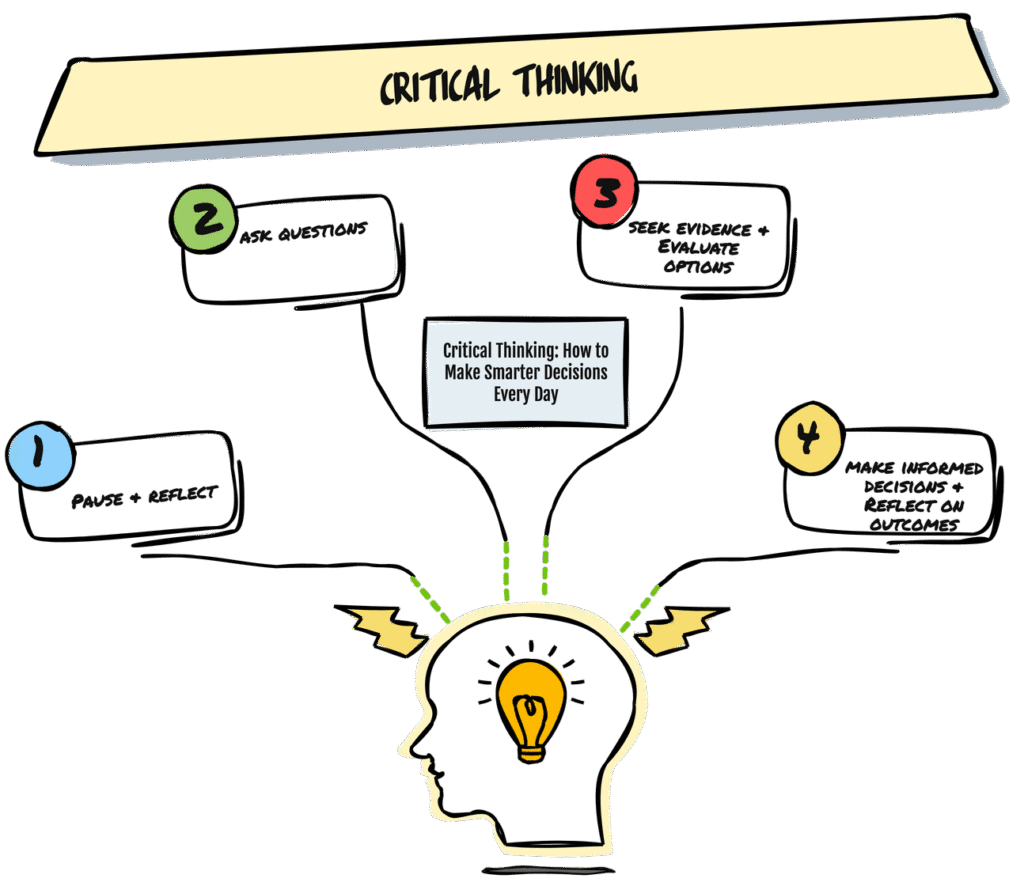Cut through confusion and make better choices at work and home. Learn simple, practical ways to sharpen your critical thinking skills.
Introduction
We’ve all been there: staring at a mountain of information, unsure what to trust or how to decide. Maybe it’s a big project at work, a news headline that feels fishy, or even a personal dilemma. That’s where critical thinking comes in—it’s like a mental flashlight that helps you see clearly in the dark. Let’s break down how to use it, why it matters, and how to get better at it (without needing a philosophy degree).
What Exactly Is Critical Thinking?
Think of critical thinking as asking better questions instead of jumping to answers. It’s not about being negative or overcomplicating things. It’s about:
- Pausing before accepting what you hear.
- Wondering, “Wait, does this actually make sense?”
- Looking for proof, not just opinions.
Example:
Your coworker says, “We need to hire more people, or this project will fail!”
Instead of panicking, you might ask:
- “What makes you say that?”
- “Have we looked at other fixes, like better tools or training?”
- “What happened last time we hired quickly?”
Why Bother? (It’s More Useful Than You Think)
1. Stop Regretting Decisions:
Ever bought something pricey because of a flashy ad, only to realize it’s junk? Critical thinking helps you spot hype and make choices you won’t regret.
2. Fix Problems Faster:
At work, it turns arguments like “This is how we’ve always done it!” into solutions. Instead of blaming, you ask, “What’s really causing the issue?”
3. Avoid Scams and Drama:
From phishing emails to social media fights, critical thinking helps you dodge traps.
Fun Fact: 85% of bosses say critical thinking is a top skill for promotions (World Economic Forum).
How to Practice (No Flashcards Needed)
1. Become a “Why?” Machine:
Channel your inner toddler. Keep asking “Why?” until you hit the root cause.
- Problem: “Our team keeps missing deadlines.”
- Why? → “Too many last-minute changes.”
- Why? → “The client isn’t giving clear feedback.”
- Why? → “We’re not asking the right questions upfront.”
Boom! Now you can fix the real issue.
2. Flip the Script:
Before deciding, ask: “What if the opposite of my idea is true?”
- Example: Thinking of launching a new product feature? Ask: “What if this actually annoys our customers?”
3. Use the “Grandma Test”:
Explain your decision to a 10-year-old (or your grandma). If they get lost, simplify your logic.
Critical Thinking at Work (Without the Jargon)
- Meetings That Don’t Suck: Next time someone says, “This will take 6 months,” ask:
- “What’s the smallest version we can test in 2 weeks?”
- “What’s the worst that could happen if we try?”
- Email Overload: Instead of forwarding a complaint, ask:
- “Is this urgent, or just loud?”
- “Who actually needs to fix this?”
Pro Tip: Pair numbers with stories. If sales drop 20%, ask: “Are customers leaving reviews saying something changed?”
What Trips Us Up (and How to Avoid It)
1. “But I’m Right!” Syndrome:
We all cling to our opinions. Combat this by saying: “I might be wrong, but here’s what I think…”
2. Speed Over Quality:
Rushed decisions often backfire. Try this: For low-stakes choices (like what to eat), decide fast. For big ones (like a job offer), sleep on it.
3. Emotional Hijacking:
Angry? Write a rant email… then delete it. Come back tomorrow.

References for the Curious
- Harvard Business Review: Smarter Decision-Making (for the nerds).
- TED Talk: How to Spot a Lie (for the skeptics).
Wrap-Up
Critical thinking isn’t about being the smartest person in the room. It’s about being curious, asking questions, and staying open to being wrong. Start small: next time you’re stuck, try the “5 Whys” or explain your problem to your dog. You’ll be surprised how much clearer things get.


